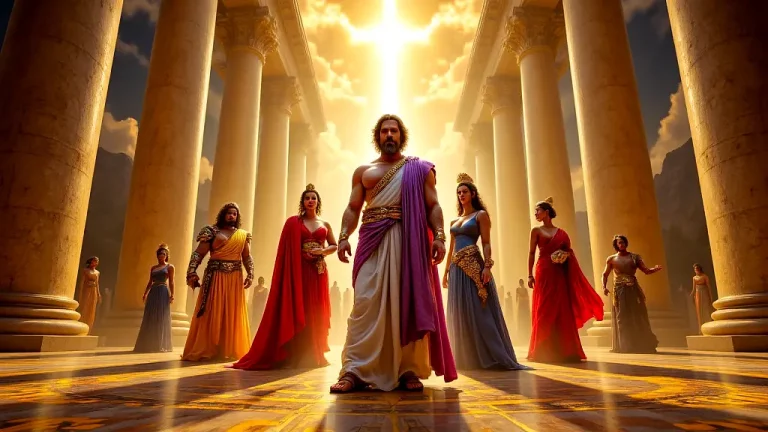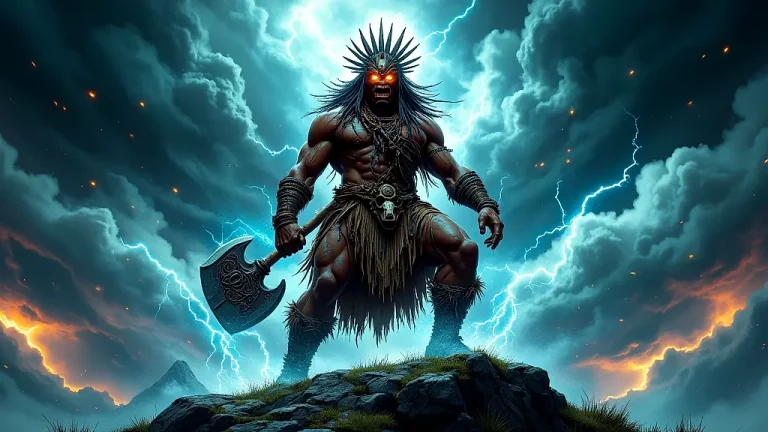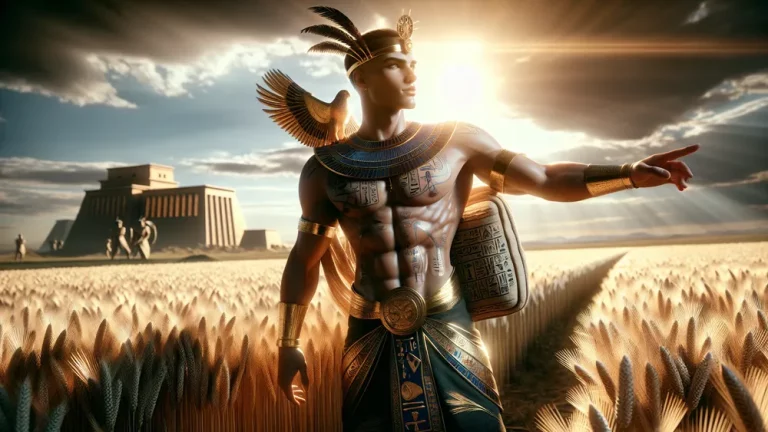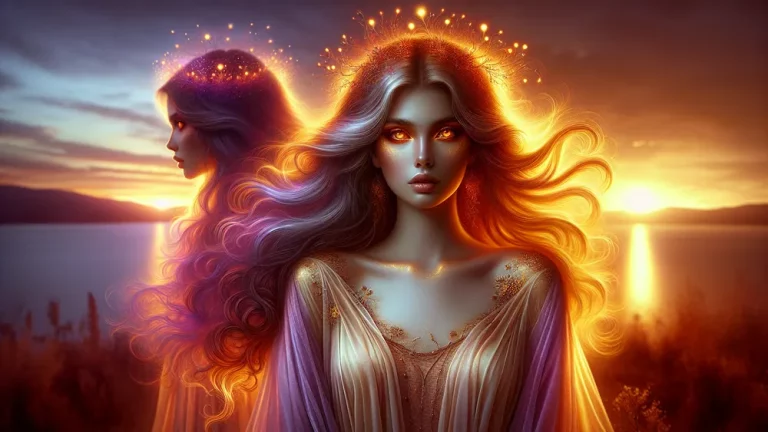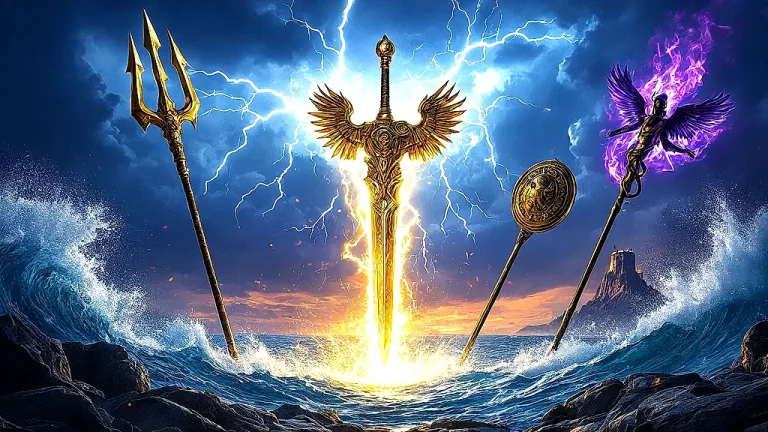Hippocampus: Poseidon’S Fish-Tailed Horse In Greek Mythology
In the amazing world of Greek myths, oceans are filled with wild creatures, none more interesting than the hippocampus – a special mix of horse and fish. It works as a kind of sea protector and a favorite of Poseidon. The hippocampus lets us explore many stories full of interest and respect.
Key Points:
- The hippocampus is a part-horse, part-fish creature tied to the sea god Poseidon.
- It means power, safety, and direction over the ocean.
- In Greek art, it appears on pots, mosaics, and more.
- Similar creatures can be seen in Roman and Egyptian myths.
- It appears often in sea-related rituals and had cultural significance.
- Sailors looked to the hippocampus for safety on ocean trips.
- Poseidon rides a chariot with hippocampi in myths.
These horse-like-fish are seen in old art and writings, meaning they are sea protectors and mysterious signs of the water world. In Greek myths, opinions about where they come from and what they do differ, showing they are important not only in stories but also in rituals and culture along the old coasts.
Through this look, we will understand the different stories about the hippocampus, from their big role as Poseidon’s strong partners to their endless life in Greek art and life, giving some idea of why these animals still hold attention and give ideas even now.
Hippocampus: Overview and Key Facts
| Key Point | Description |
|---|---|
| Mythological Origin | In Greek mythology, the hippocampus comes from stories showing it as a creature, part horse at the front and part fish at the back. |
| Associated Deity | Tied closely to Poseidon, the god of the sea, earthquakes, and horses. He is often seen in art as he drives his chariot over the ocean. |
| Symbolism | Means power, protection, and guidance over the sea, and it is a sign of safety for sailors and fishermen on tricky water. |
| Cultural Significance | In old Greek art, like on pots, mosaics, and statues, it appears a lot, which obviously mattered a lot back then. |
| Variations in Mythology | Although mainly in Greek stories, you can see similar creatures in Roman and kind of in Egyptian tales, too. |
| Role in Rituals | In sea-related religious events and festivals for Poseidon, the hippocampus was a symbol that shows its importance for people who sail. |
| Artistic Depictions | Frequently shown in active artwork like friezes, with detailed looks that highlight it being part horse and fish. |
| Symbol of Naval Strength | Means ancient Greek naval power and control, often found on coins and emblems as a sign of sea strength. |
The Hippocampus in Greek Mythology
To really get why the hippocampus matters, we must dig into its old story roots and its mixed ties with the strong Poseidon, so we find the many stories that placed it deeply in Greek culture’s history.
Beginnings and Meanings of the Hippocampus
The beginnings of the hippocampus in Greek mythology have a close connection with the huge area of sea controlled by Poseidon, a god. He is thought to lead these big sea animals as a sign of what he could do and as defenders of his undersea kingdom.
In stories, although how the hippocampus came to be isn’t always clear, they often appear as friends of Poseidon, and they boost his god-like traits, working like his hands throughout the seas.
These sea beings look like they have the body of a horse at the front and a fish’s tail, meaning a smooth mix of land and water areas and Poseidon’s control over both earth and ocean. Their split form is important; it stands for things like freedom and having no limits.
Compared to a modern idea, like saying their combined shape is like hybrid cars going through different places easily. Not just part of Poseidon’s group, they mean keeping the sea’s people safe.
When thinking about meanings, the hippocampus takes on key roles in Greek stories, often seen in tales and writings with many traits. Below is a list that emphasizes some main meanings tied to the hippocampus:
- Guardian and Protector: Usually seen as sea guards, keeping sailors and fishermen safe.
- Symbol of Strength and Power: Means Poseidon’s strength and respected like the sea’s own energy.
- Guides and Messengers: Sometimes described as helpers for souls or messengers between worlds, hinting at a bridging role.
- Emblems of Fertility and Abundance: Linked to the sea’s richness and the life it supports.
These meanings are from many old writings, like ones by Homer and Hesiod, aiming to show the wonder and might of the sea and its mythical watchers. Thus, the hippocampus is a key figure representing ideas of safety, power, and the mysterious sea’s secrets.
The hippocampus in Greek mythology symbolizes Poseidon’s power, freedom, and guardianship over the sea, embodying traits like strength, protection, and the mystery of the underwater world.
Poseidon and His Fish-Tailed Horses
Poseidon, one of the powerful gods in the Greek set, ruled the seas. Often appearing in pictures of him riding in a big chariot pulled by strange sea horses called hippocampi, these creatures mean much more than adding to his grand image. Part of who he was, they made him a god of land and water.
Created by Poseidon, in stories, to show his control over horses – shown by their front parts – and the wide oceans, where their fish tails helped them move through water easily. This mix hints at his rule over both areas, similar to how guards today stand for traditions and the present.
Found in old art and books like those by Apollonius Rhodius, Poseidon’s rides with these amazing creatures give a picture of heavenly power brought to Earth and show his role in balancing sea and land.

These stories with Poseidon’s big sea horses tell different ideas and events, pointing out their place in old Greek life. These creatures were more than just made-up things; they meant larger ideas that linked gods with people. Here’s a list of main ideas about Poseidon and the hippocampi:
- Transportation Over the Waters: As a symbol of full control, they pull his chariot, meaning Poseidon’s hold over the sea and quick travel.
- Protective Helpers: Guards of his water world, they meant both danger and beauty of the ocean, helping sailors who respected Poseidon.
- Samples of Power and Respect: With a fancy look and tied to Poseidon, they stand for great power and have the same honor the sea gets.
- Impact on Culture and Art: Often seen in Greek art and stories, these creatures show how much the Greeks respected the sea life.
Through these tales, Poseidon’s fish-tailet horses come out as clear signs of his rule, standing for the strong and unknown nature of the sea – something honored in old Greek myths.
How the Hippocampus Was Shown in Old Art and Stories
In old Greek art and stories, the hippocampus was often shown in a way that highlighted how it mixed different elements, being part horse and part fish, combining a horse’s style with the smooth movement of a fish. It was shown often by artists on painted pots and in detailed tile pictures, pulling Poseidon’s chariot.
This strong image was a clear sign of his rule over the sea. The hippocampus appears in many types of art, quite like how imaginary dragons appear in Asian cultures, where they also held important roles. Words on pottery often showed these creatures in moving scenes that capture the sea’s mood, indicating the sea as always powerful.
Written accounts, like those by Roman writer Ovid and Greek historian Diodorus Siculus, further made this creature part of culture, with words that gave the hippocampus a place not just in art but also in the shared thoughts of old societies.
The Role of the Hippocampus in Ancient Greek Culture
When we move away from pictures of myths to real importance, the hippocampus comes out as a major part connected with many parts of ancient Greek life and traditions.
The Hippocampus in Religious Rites and Groups
In old Greece, the hippocampus held an important place within many religious rites, mainly for Poseidon, the god who controlled the seas and horses. In many rites, there were processions and sacrifices that aimed to make sure sea trips were safe and weather was good, with the hippocampus acting as a middle man between people and gods.
Similar to other religious signs across the world, like the lotus in Hinduism that means purity and cosmic balance, the hippocampus symbolized the fertility and vastness of the sea. Statues sometimes showed the hippocampus with Poseidon, showing their main role in rites and celebrations that honored the sea god and sought his help.
These religious events often happened during festivals such as the Isthmian Games, where there were athletic contests, music, and poetry, all supported by rituals that often called on the hippocampus as a guardian and protector.

During those events, the hippocampus was more than just an art subject; it meant maritime prosperity and divine favor, believed to give safety to communities that relied on the sea for trade and food.
The sea-driven culture of the Greeks and their dependence on the sea for living and discovering made the hippocampus, as Poseidon’s sign, resonate deeply with those doing such religious acts, becoming a lasting figure within the circle of Greek sea gods.
Hippocampus as a Sign of Sea Strength
Throughout ancient Greek culture, people respected the hippocampus as a strong sign of the sea’s power, like how current signs such as the eagle or lion mean national pride and power. Mariners and naval leaders would often place the hippocampus on their boats and tools, believing it gave safety and good luck on dangerous trips. To them, this creature seemed not just an aquatic animal but an indivisible part of the sea’s might. Seen in everything from large ships of the Athenian warriors to small fishing boats on the Aegean, it meant strength and resilience which were vital to Greece’s identity as a sea-centered civilization. The table below allows us to compare the hippocampus with other sea symbols in Greek culture:
| Nautical Symbol | Shows Strength | Cultural Importance in Greece |
|---|---|---|
| Hippocampus | Sea power, safety | Sign of Poseidon’s strong area and ocean control |
| Trident | God authority | Means Poseidon’s rule over the sea |
| Nautical Star | Guidance, finding way | Used in finding way, sailor protection |
| Dolphin | Good luck, quickness | Linked to Apollo, sign of good signs |
This comparison means how the Greeks’ idea of sea power was deeply in their stories, with the hippocampus being a key figure in their symbol list.
In ancient Greek culture, the hippocampus, symbolizing sea power and safety, was an important emblem infusing strength and resilience into Greece’s sea-centered identity.
Hippocampus in Greek Trade and Sea Journeys
In the mix of ancient Greek trade and sea journeys, the hippocampus appeared as a steady sign connected with the search for success and new places. Greek traders and sailors called on the hippocampus not just for decoration but as a real call for Poseidon’s favor, making their trips connected with godly protection, similar to modern sailors possibly carrying good luck items or doing certain acts before a trip.
That were on ship fronts and marked on coins, they thought the hippocampus helped guide and protect the workers and their boats, assuring them safe travel across hard waters. To the Greeks, who treated sea business as a part of Poseidon’s endless land – the ocean, both a known friend giving food and a wide space needing respect, this creature meant much.
So, the hippocampus stood for the real meeting of stories and real life, where the divine and humans went into business and exploring on the big, open sea.
Comparing Myths: Views on Mixed Creatures
Now, moving from the focus on the hippocampus, we make our view wider to look at how mixed creatures are seen across different mythological traditions. These views differ in many ways.
The Hippocampus in Other Ancient Stories
Looking past the limits of Greek tales, the idea of fish-taíled animals like the hippocampus comes up in lots of other mythological traditions. Romans, who often took ideas from Greeks, had fantastic beings named hippocampi or ichthyocentaurs, linked with Neptune, the Roman version of Poseidon. In Roman art, especially in mosaics and wall paintings, these creatures are seen with Neptune, who represents sea power and the sea’s unknown parts.
The combination of a horse and aquatic form shows both strength and grace. These themes are important in Roman stories about their gods’ control over nature’s forces. In Egyptian art, creatures called “sea horses” appear. But they don’t completely match the horse-fish hybrids. These are more abstract, related to gods like Sobek, the crocodile god.
Sobek shows a mix of land and water ideas, like the hippocampus’s dual nature. This shows how different societies like to give hybrid creatures a role with gods, suggesting the sea as strange and powerful. People see them differently though, as some say they are more symbols than real beings, highlighting the vague nature in old storytelling traditions.
Such beings in many tales emphasize how humans want to personify the strange parts of nature using familiar yet magical forms. Comparing the hippocampus to symbols like mermaids or dragons helps link storytelling through time, trying to explain mystery through imagination.
While details and stories might change, the main idea of the sea as a place of wonder and challenge is common, sparking curiosity and showing how humans relate to nature in many cultures.
Ocean Mixes in Myths
In different myth stories, the ocean is often filled with mysterious ocean hybrid creatures, each meaning something about the sea’s unknown and surprising nature. From the half-human, half-fish merfolk, found in many cultural stories, like in old Assyrian myths to European legends, to the Nāga, snake-like beings in Hindu and Buddhist traditions known to live in water places and are seen as protectors. These creatures mean a lot in cultural stories.
They both allure and warn, representing the interesting and risky parts of the ocean, much like today’s views of the sea as a life source and powerful force.

Notably, these creatures in myths that inspire and make people wonder include:
- Mermaids/Sirens: Known in Assyrian, Greek, and later European tales, often seen as a symbol of the sea’s allure and danger.
- Nāga/Nagini: Seen as water protectors in Hindu and Buddhist thoughts, reflect what water means spiritually and protectively.
- Kraken: A huge sea monster from Scandinavian stories, stands for the unknown fear of deep waters.
- Aspidochelone: A big sea creature in old bestiaries, often thought of as an island, misleading about the ocean’s calm looks.
- Amphitrite’s Creatures: Linked with the Greek sea goddess, showing how ancient people saw the ocean’s sides.
These imaginary beings are not just made-up ideas; they help us see how older and current cultures link with nature, using symbols to explain natural events and our ties to the sea. This shared idea highlights how stories are cultural points, keeping alive common fears and fascinations about the ocean in many places.
The Fall and Comeback of the Hippocampus
After looking at the many stories with ocean hybrids, it’s time to explore the interesting path of the hippocampus, and how it experienced a fall before coming back in later times.
After-Classical Myths and Art
After the times of old Greece and Rome, the hippocampus slowly faded from popular stories and pictures, as other main figures and tales took over. The Middle Ages barely saw its images, with Christian symbols and earthly hybrids like griffins and unicorns taking the spotlight. But during the Renaissance when old themes came back, people got interested in Greek and Roman art again.

This energetic rebirth was when the hippocampus began to appear in art, especially in building decorations and sculptures on fountains, showing the sea as a wild and strong force that matched the Renaissance’s love for nature and humanism. This return didn’t happen everywhere. For example, in Italy where Renaissance art was very influential, the hippocampus became a big deal in large sculptures and paintings, accompanying Neptune or sea scenes in great detail.
It was like how modern culture gets interested again in old art or fashion. Meanwhile, in seafaring nations like the Netherlands, people used sea themes, so images of the hippocampus appeared in maps and engravings, symbolizing the new discoveries and sea power of the time.
The different uses show how local styles and art trends could make the hippocampus either a big focus or just a nod to classical accuracy, connecting old myths with new art ideas.
After the decline of ancient Greece and Rome, the hippocampus faded from stories and pictures until the Renaissance brought a renewed interest in Greek and Roman art, where it carved a niche in European art, mainly in Italy’s grand sculptures with sea themes and maps in seafaring nations, highlighting cultural connections between old myths and new discoveries.
Old Stories and Bidding Tales
In the mix of European folklore, the hippocampus stayed as a mythical being linked to sea stories, often seen in stories as guards of hidden treasures or strange signs facing sailors. As stories passed through spoken traditions from the Celtic and Nordic people, the magical pull of these creatures made sea stories richer.
Similarly to modern stories passed around, these tales adjusted with each new telling, fitting the speaker’s place and culture. This way, the hippocampus lived on past its ancient roots. It showed up in fairy tales and sea songs from fishing groups that valued what it meant about the ocean’s hidden secrets. Frequently, these stories pictured the hippocampus as both a helpful friend and a danger to sailors.
It meant the two-sided nature of the sea, providing both work and risk. Hence, the hippocampus moved easily from old stories to shared memories in maritime communities, where it still charmed and warned sailors through many years.
Pantheon of Marine Mythical Creatures
When you look into the group of marine mythical creatures, you find an interesting variety that covers cultures and times; this captures the ocean’s ability to inspire stories and ideas. You see creatures like the leviathan from Hebrew texts, which means chaos and early power, and the alluring sirens from Greek stories who sang sailors to disaster.
These creatures often mean the wide, wild forces of nature. Strangely, these mythical beings are like our modern wonder about parts of the ocean we don’t know and the strange life there.
Also, if you are curious about the many types of these mythical creatures, check out a Greek Creatures and Monsters list, which gives detailed looks into their stories and importance in history, effectively connecting old myths with ongoing interest in study.
Each creature acts as a story holder, bringing tales of human meetings with the frightening and amazing parts of the ocean world, showing how humans remain drawn to what is under the waves.
FAQs
1. What was the role of the hippocampus in Poseidon’s mythology?
In Poseidon’s mythology, the role of the hippocampus was to serve as the divine fish-taied creatures that drew the god’s chariot across the sea.
2. How did ancient Greeks depict the hippocampus in their art?
In ancient Greek art, the hippocampus was often depicted as a majestic creature with the foreparts of a horse and the tail of a fish, frequently adorning pottery, sculptures, and mosaics.
3. Are there similar creatures to the hippocampus in other mythologies?
Yes, similar creatures to the hippocampus appear in other mythologies, such as the Roman Oceanus and the Mesopotamian dragon-like Tiamat.
4. Why was the hippocampus significant to sailors in ancient Greece?
The hippocampus was significant to sailors in ancient Greece because it symbolized protection, ensuring safe sea voyages under the guardianship of the god Poseidon.


